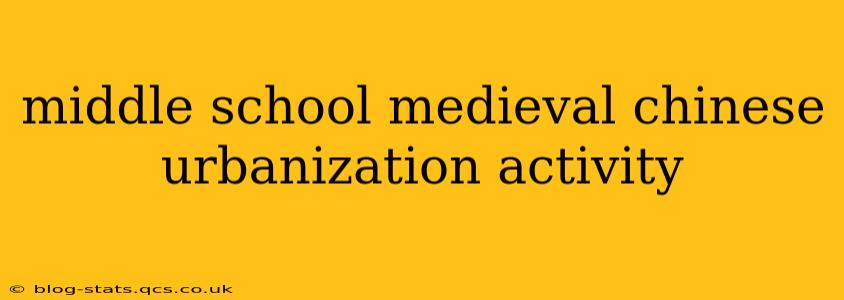This activity immerses middle school students in the fascinating world of medieval Chinese urbanization, moving beyond textbook learning to foster deeper understanding and engagement. We'll explore the key characteristics of medieval Chinese cities, the societal structures that shaped them, and the challenges faced by their inhabitants. This lesson plan incorporates interactive elements to make learning fun and memorable.
What Made Medieval Chinese Cities Unique?
Medieval Chinese cities differed significantly from those in Europe or other parts of the world. They were often planned, with grid-like layouts, reflecting a strong centralized government's influence. Unlike many European cities that grew organically, Chinese cities were often built according to a design, showcasing sophisticated urban planning for the time. Key features included:
- Walls: Massive city walls provided protection and control, defining clear boundaries.
- Canals: Extensive canal systems facilitated trade, transportation, and waste management.
- Residential Areas: Clearly defined residential sections, often segregated by social class.
- Commercial Centers: Bustling marketplaces and commercial districts formed the economic heart of the city.
- Government Buildings: Impressive government buildings, temples, and palaces dominated the cityscape, symbolizing imperial power.
Activity 1: Designing a Medieval Chinese City
This hands-on activity allows students to actively engage with the concepts discussed. Divide the class into groups and provide each with:
- Map Grid: A large grid representing the city layout.
- Cutouts: Cutouts of different building types (residential houses, shops, government buildings, temples, canals, city walls). Vary the size and complexity of cutouts to reflect social status (larger buildings for the wealthy elite, smaller for the common people).
- Research Materials: Brief descriptions of various aspects of medieval Chinese cities (e.g., social structure, economic activities, technological advancements).
Students will work together to design their own medieval Chinese city on the grid, placing the building cutouts strategically. Encourage them to consider factors like:
- Social Stratification: How will different social groups be located within the city?
- Economic Activities: Where will the marketplace and workshops be situated?
- Infrastructure: How will canals and roads be used to connect different parts of the city?
- Defense: How will the city walls provide protection?
Activity 2: Role-Playing: A Day in the Life
To further enhance understanding of daily life, introduce a role-playing scenario. Assign students different roles within the city:
- Merchant: Selling goods in the marketplace.
- Artisan: Crafting goods in a workshop.
- Government Official: Managing city affairs.
- Farmer: Bringing produce into the city.
- Commoner: Living in a residential area.
Students will then act out a day in their assigned roles, interacting with each other and describing their experiences. This activity encourages empathy and a deeper understanding of the diverse lives within the medieval Chinese city.
H2: How did the government organize medieval Chinese cities?
The imperial government played a crucial role in organizing medieval Chinese cities. They oversaw city planning, infrastructure development, and the administration of justice. The sophisticated bureaucracy ensured effective governance and a degree of social order in these densely populated urban centers. Centralized planning and control were key elements of this organization.
H2: What were some challenges faced by people living in medieval Chinese cities?
Despite the impressive urban planning, residents of medieval Chinese cities faced various challenges:
- Overcrowding: High population density often led to unsanitary conditions and the spread of disease.
- Poverty: Significant disparities in wealth existed, with many living in poverty.
- Crime: Urban centers often attracted criminal activity.
- Natural Disasters: Cities were vulnerable to floods, fires, and earthquakes.
H2: What role did trade play in the growth of medieval Chinese cities?
Trade played a vital role in the growth and prosperity of medieval Chinese cities. The Grand Canal, for example, facilitated extensive internal trade, connecting different regions and fueling economic expansion in urban centers. The bustling marketplaces served as hubs for commerce, attracting merchants and artisans from far and wide.
Conclusion
This activity provides a dynamic and engaging approach to learning about medieval Chinese urbanization, moving beyond rote memorization to a deeper understanding of historical context. The combination of hands-on design, role-playing, and research fosters critical thinking and collaborative learning, leaving students with a more comprehensive appreciation of this significant period in history.
